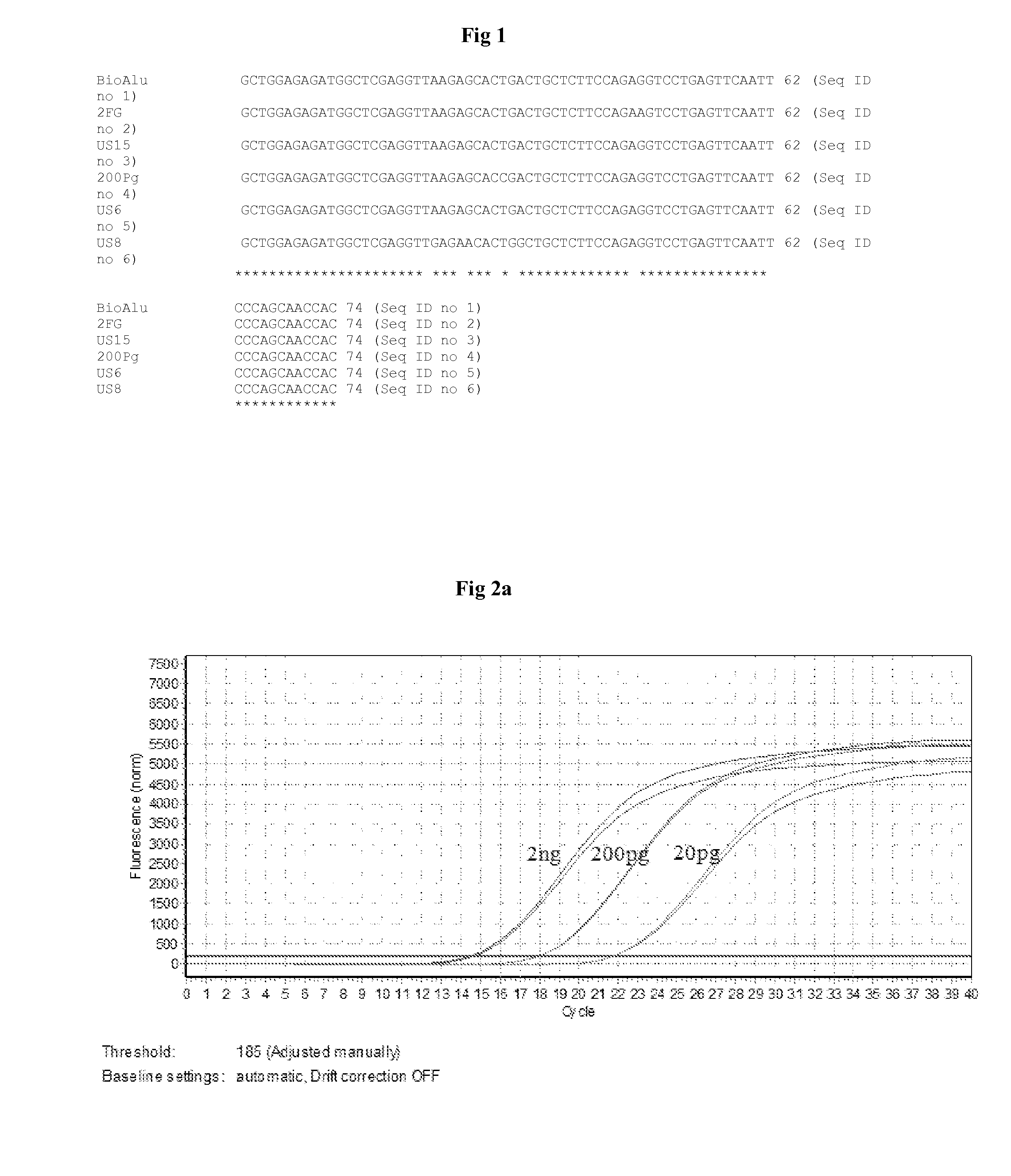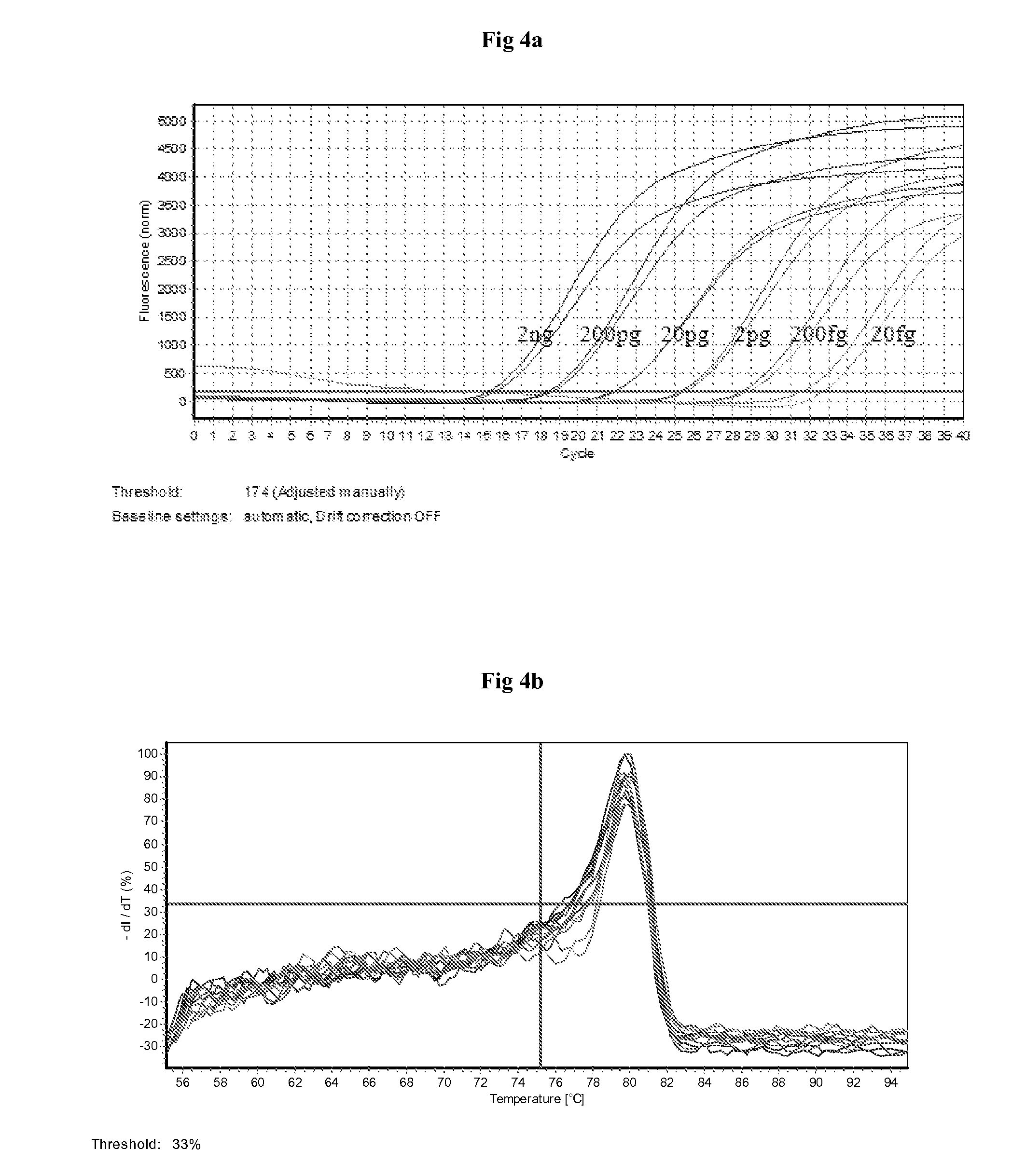Method of detecting residual genomic DNA and a kit thereof
a genomic dna and kit technology, applied in the field of methods of detecting residual genomic dna, can solve the problems of lack of sensitivity and specificity, limited traditional methods of quantitating residual host cell dna, and slow tim
- Summary
- Abstract
- Description
- Claims
- Application Information
AI Technical Summary
Benefits of technology
Problems solved by technology
Method used
Image
Examples
examples
Example: 1
Biological Sample
[0151]Any monoclonal antibodies or therapeutic proteins expressed in CHO—S cell line (obtained from Invitrogen cat#11619012).
Preparation of Standard DNA:
[0152]Genomic DNA from CHO cells is extracted from monoclonal antibody production strain by following phenol chloroform extraction method. DNA is resuspended in 10 mM Tris-1 mM EDTA, pH 8.0, the concentration determined, and diluted to a storage concentration of 100 ng / μL and a working concentration of 10 ng / μL. This DNA is used as Standard in qPCR.
Extraction of DNA from Biological Sample:
[0153]DNA from biological sample is extracted by using silica based DNA extraction columns where DNA binds to the silica membrane due to change in pH to acidic and DNA is eluted from the membrane with the addition of water which changes pH to neutral.
Example: 2
Materials and Method
[0154]The primers are obtained from Eurofins (Germany) and probe from Eurogentec (Belgium). Real time PCR machines Mx3000P from Stratagene and R...
example 10
Sequence Comparison of the Target Sequence with Other Alu Targets
[0204]The target sequence designated as SEQ 1 is compared with the Alu-equivalent sequences available in public domain. Since the rational of seq ID 27 & Seq ID 28 is being used as target Alu sequence for residual DNA quantification from biological proteins as described in patents US2009325175 and U.S. Pat. No. 5,393,657 respectively. Therefore the following sequence comparison of Seq ID 1 with Seq ID 27 & 28 was performed to identify the sequence variations between the target identified in present disclosure and those reported in public domain.
[0205]The published sequences designated as SEQ ID 27 and SEQ ID 28 are compared with the seq ID 1 using the CLUSTAL W online software. The percentage homology observed with the sequence ID 27 is 50% and hence the percentage variance is 50% (FIG. 21a). The comparison of sequence ID 1 with the sequence 28 revealed percent homology as 71.6% and hence the percent variance is 28.4% ...
example 11
Presence of Other Alu Targets in the Genomic DNA
[0206]The two PCR products amplified from CHO genomic DNA by using the primers SEQ ID 25 and SEQ 26 and SEQ ID 29 and SEQ ID 30 are sequenced. Sequencing results revealed the presence of similar sequences with 5% variation with that of the SEQ ID 27 (FIG. 22a) and 21% variance with that of the SEQ ID 28 (FIG. 22b).
PUM
| Property | Measurement | Unit |
|---|---|---|
| temperature | aaaaa | aaaaa |
| temperature | aaaaa | aaaaa |
| concentration | aaaaa | aaaaa |
Abstract
Description
Claims
Application Information
 Login to View More
Login to View More - R&D
- Intellectual Property
- Life Sciences
- Materials
- Tech Scout
- Unparalleled Data Quality
- Higher Quality Content
- 60% Fewer Hallucinations
Browse by: Latest US Patents, China's latest patents, Technical Efficacy Thesaurus, Application Domain, Technology Topic, Popular Technical Reports.
© 2025 PatSnap. All rights reserved.Legal|Privacy policy|Modern Slavery Act Transparency Statement|Sitemap|About US| Contact US: help@patsnap.com



